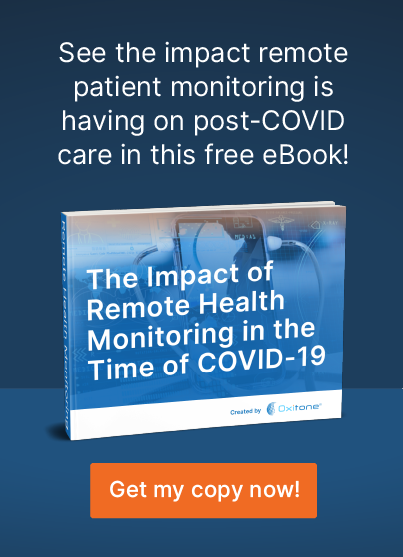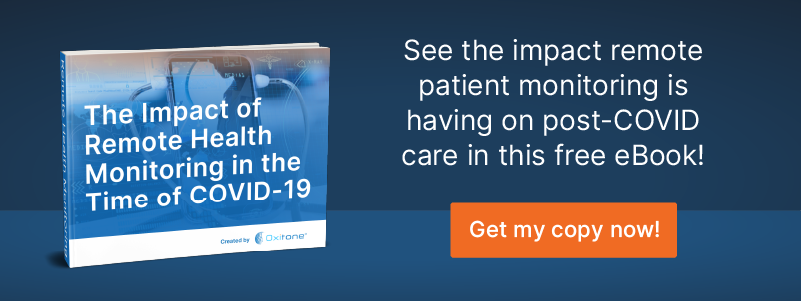We know that remote patient monitoring (RPM) can be transformative for chronic disease patients, including those with respiratory conditions like COPD. But as more information about the aftermath of COVID-19 infection comes to light, it’s becoming increasingly apparent that RPM also has relevant applications in post-COVID care and recovery.
Unfortunately, the question isn’t as simple as, “Are you using RPM?” when it comes to treating recovering COVID-19 patients. The right RPM kit can improve patient outcomes and reduce readmissions, while the wrong one can create limitations that prevent those positive effects.
When choosing the right RPM strategy, success often boils down to whether patients have access to continuous remote patient monitoring, or CRPM. New information continues to emerge about best practices in the care of post-COVID patients. Here is what we know so far about using CRPM effectively and efficiently in the care of patients recovering from COVID-19.
Post-COVID Care Needs
RPM can have transformative effects on patients suffering from chronic diseases and COPD. That said, patients recovering from COVID-19 have unique needs for their care that must be taken into account.
Patients discharged from hospitals after a COVID-19 infection are stable but are still required to self-isolate for several weeks to prevent the spread of infection. Consistent follow-up with patients is necessary to monitor patients’ symptoms and ensure compliance with quarantine measures in recovery.
By remotely monitoring patient metrics, such as body temperature and oxygen saturation, doctors can determine if patients are no longer contagious without asking infectious COVID-19 patients to make in-person appearances. As a result, other patients treated in the same clinics can stay safe.
The ability to remotely monitor patients is of particular importance, given the number of COVID-19 patients who experience “long-haul” symptoms. Approximately 10% of COVID-19 patients become long-haulers. These patients can be impacted for months beyond their initial infection with the coronavirus, with widely varying timelines for illness and recovery.
Other patients go on to develop long-term complications. These conditions can emerge more than four weeks after developing COVID-19 and may include multiorgan inflammation syndrome and autoimmunity. Following these patients requires diligent and frequent monitoring.
Benefits and Limitations of CRPM for COVID-19 Patients
Monitoring long-haul and complex COVID-19 patients is essential, yet to do so traditionally could overwhelm outpatient clinics, taking time and resources away from other patients. RPM allows doctors to keep an eye on long-haul patients without placing an excessive burden on their staff, which becomes especially beneficial as more patients make appointments to get the COVID-19 vaccine.
But not all RPM strategies are created equal. Specifically, CRPM has been found to improve the care of COVID-19 patients post-infection. In fact, artificial intelligence-powered CRPM technology has even helped one hospital—Baptist Health in Louisville, Kentucky—achieve zero readmissions of COVID-19 patients.
In addition to improving the care of COVID-19 patients released from the hospital, CRPM technology, like all RPM technology, reduces the need for in-person medical visits, protecting other patients in a practice from contracting the virus. Fewer sick patients lessen the burden of COVID-19 cases on the typical outpatient clinic’s daily operations.
The apportionment of staff is of special importance during a public health crisis such as the COVID-19 pandemic. CRPM reduces the amount of manual data entry required by traditional RPM, lessening the burden of care of patients recovering from COVID-19 on healthcare staff. They can then provide more care to more patients.
Traditional RPM systems may also create issues with patient compliance. Some RPM kits, such as the one used at Mayo Clinic, come with an abundance of pieces: blood pressure cuffs, thermometers, pulse oximeters, weight scales, etc. These oversized kits complicate the RPM process for patients, creating confusion and reducing compliance. They also cost more time and money for hospitals to put together than integrated CRPM kits that combine these elements into one convenient tracking system.
This complication highlights the importance of choosing the right RPM system for your hospital or clinic: CRPM devices, such as Oxitone, can measure a wide array of variables with a single piece of wearable technology, including oxygen saturation level and body temperature. Putting fewer pieces in an RPM kit improves patient compliance by facilitating ease of use.
The comfort of Oxitone also makes it an optimal choice for CPRM of COVID-19 patients after infection. Alternative devices that have been developed do not bear comfort in mind the same way: one CRPM device, created by Northwestern University, sits awkwardly at the base of the throat. Patients who find this uncomfortable may be less likely to use the device and comply with their doctor’s recommendations for post-COVID monitoring and care. Oxitone can be worn comfortably on the wrist with the same familiarity as a simple fitness tracker.
Here at Oxitone, we boost value-based healthcare by delivering extraordinary patient, clinical, and economical outcomes at reduced medical utilization and cost. Patients need a prompt response to emergencies. Physicians need an easy and timely follow-up with patients. Our mission is to transform chronic disease management and help save lives worldwide.
Let’s save lives together! To see how we help remote patient monitoring companies and physicians improve the management and care of high-risk patients, contact us today!


